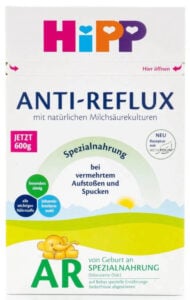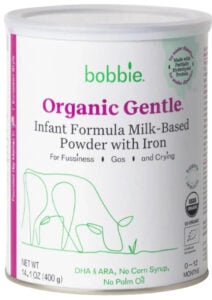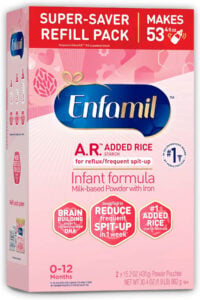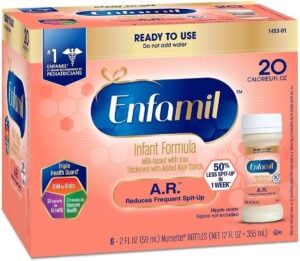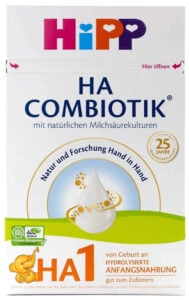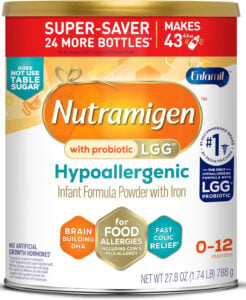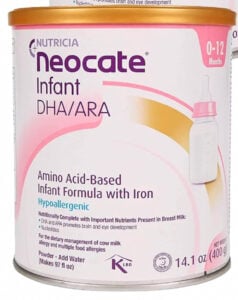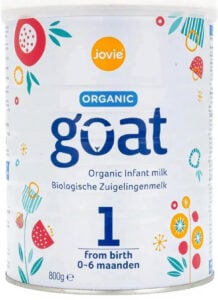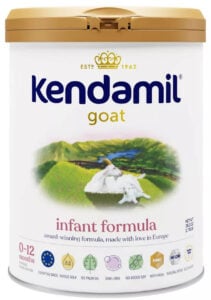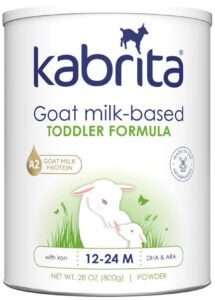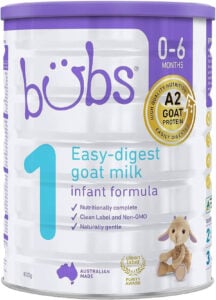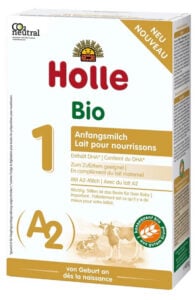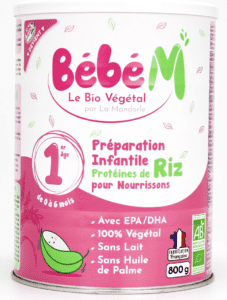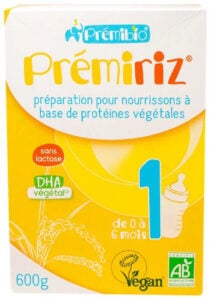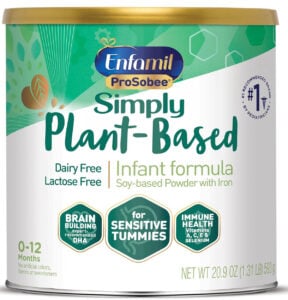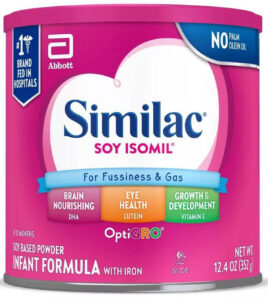Health
The Best Formulas For Reflux & Spitting Up (2024 Guide)

This post may contain affiliate links. As an Amazon Associate, I earn from qualifying purchases. Please read my disclosure.
Does your baby spit up frequently after feeding? Acid reflux, or a condition wherein food and stomach acid back-flow into the esophagus and throat, is common for young babies. In this in-depth and parent-friendly guide, I explain what causes acid reflux, how mild and severe cases differ, and I will share the list of the best acid reflux formulas to help your baby be comfortable, grow, and thrive.
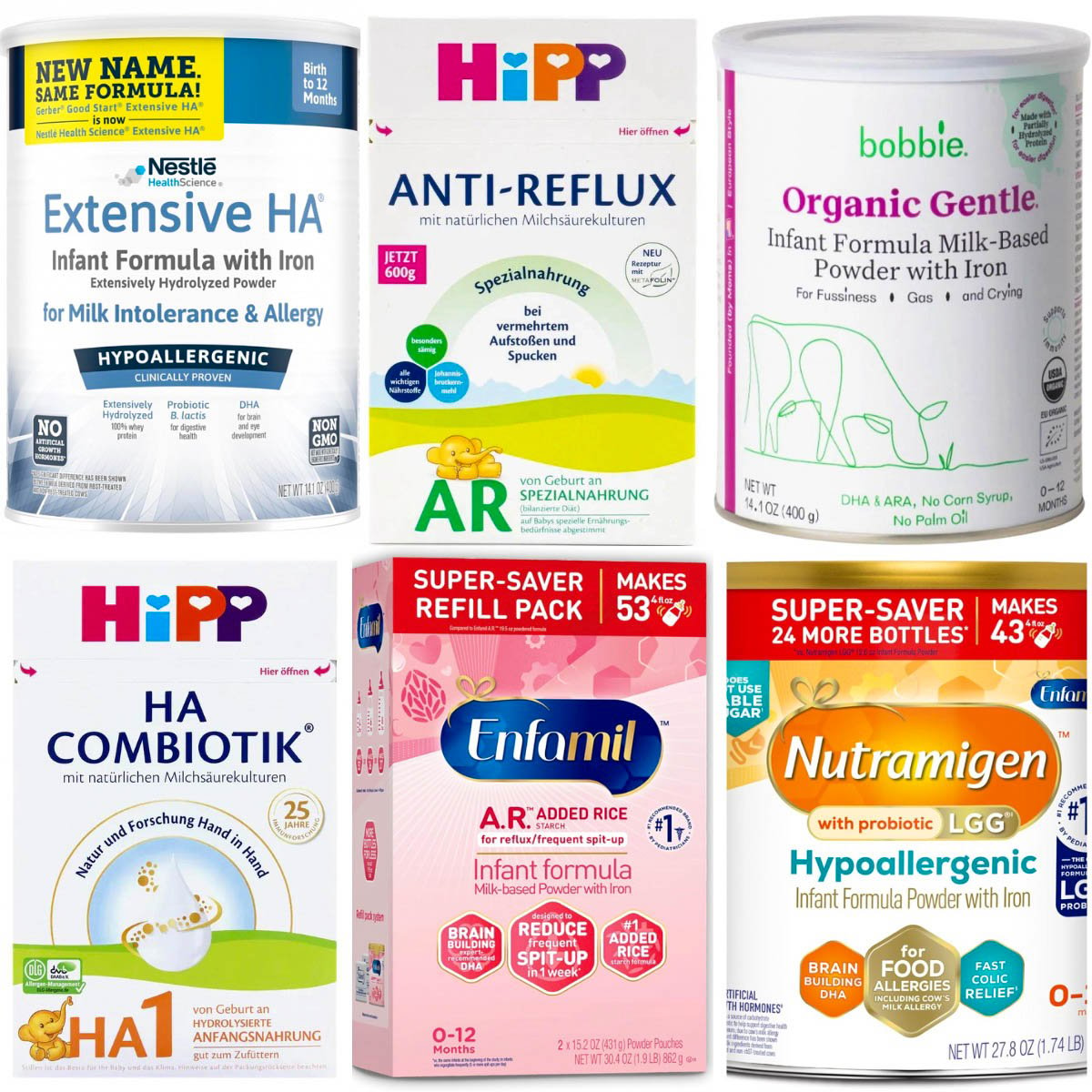

Finding the best baby formula for your little one can be stressful, but if you need to find an acid reflux or hypoallergenic one, the process is even more difficult. I know how confusing it can be to try to figure out what is causing your baby’s reflux! And, even once you discover the cause, it’s equally confusing to make sense of all the different acid reflux-related formulas available, and figure out what really is the best baby formula for reflux.
Many babies spit up – it’s a normal part of infancy (source). Sometimes, however, it may seem like your baby barely keeps anything down or you may be concerned about their failure to gain weight or grow because they are spitting up so much.
So when do you know if your baby’s spit up is something to be worried about? In this post I will review what infant acid reflux is, the differences between normal and mild reflux and severe reflux, when you need to be concerned and see a doctor, and the best anti reflux formulas on the market today.
But First, A Disclaimer
As a board certified health coach and certified nutritionist, I support products and ingredients that are rooted in science and are evidence-based. Using my background in nutrition, along with extensive research, consultations with experts, and my own experience giving my two kids formula, I was able to arrive at this list of the best formulas for acid reflux in this guide. This guide has also been medically reviewed and fact-checked by Christina Badaracco, MPH, RDN, LDN. (see my about page for more info about Christina).
Though I may receive a commission (at no extra expense to you) if you purchase through some of the affiliate links provided, I only recommend products I’ve researched, evaluated, consulted experts on, and would feel comfortable giving to my own two children.
As always, I only share products that are the highest quality and that can help you and your family the most. By purchasing any of these products from the links below, you help keep this blog running, so thanks for your support!
Keep in mind that every baby & situation is different, especially when it comes to reflux, so always consult your child’s pediatrician to diagnose and treat reflux before starting or switching to a new formula. My recommendations are not a substitute for professional medical advice, diagnosis, or treatment.
What Is Acid Reflux?
Infant acid reflux is when a baby spits up recently consumed liquid or food (source). Specifically, the food or liquid consumed reaches the stomach but then returns back up to the esophagus, or the feeding tube that connects the throat to the stomach (source). More than half of all babies experience gastroesophageal reflux (or GER) within the first 5 months of life (source); such reflux usually develops by 3 weeks of age and is resolved by the time babies are 12 to 18 months (source).
Acid reflux occurs at high rates in infants because the esophageal sphincter (or valve) that prevents food from flowing from the stomach to the esophagus is not developed or strong enough yet to hold in all of the stomach’s contents (source). Acid reflux can also be caused by lactose intolerance when babies lack the enzymes necessary to digest lactose in infant formula (source), or milk allergies when they cannot digest the complex proteins found in baby formula (source).
The most common form of reflux is called gastroesophageal reflux (GER) and looks like regurgitating or spitting up liquid or food. If babies are gaining weight and developing normally, this form of GER isn’t typically a cause for concern. In this mild form, babies are often relieved after spitting up, as doing so releases pressure in their digestive tract (source). Because of this, GER is also referred to as “happy spitter” or “milk reflux.”
Occasionally, GER can develop into gastroesophageal reflux disease (GERD), a more serious and long-lasting form of reflux. When suffering from GERD, the reflux episodes are persistent enough to irritate or cause damage to the lining of the esophagus (source). This irritation and damage often results in a reduced desire or ability for your baby to feed which then interferes with their growth and development (source).
A third type of reflux is silent gastroesophageal reflux disease (silent GERD). This form is “silent” because outward symptoms of the reflux are not always present. That is, the contents of the stomach only reach the esophagus and are not expelled from the mouth, making it tricky for parents and medical providers to notice and diagnose (source).
Note: Though vomiting and GERD overlap, they are not always the same. Some people interchangeably use the terms “vomit” and “spit up,” but vomiting is more forceful and is a larger amount (source). Spitting up is smaller in quantity (even though it can look like a lot) and doesn’t project as much, even if your baby does so more forcefully. If your child consistently projectile vomits or if their vomiting seems unrelated to acid reflux, it is important to talk to your baby’s doctor (source).
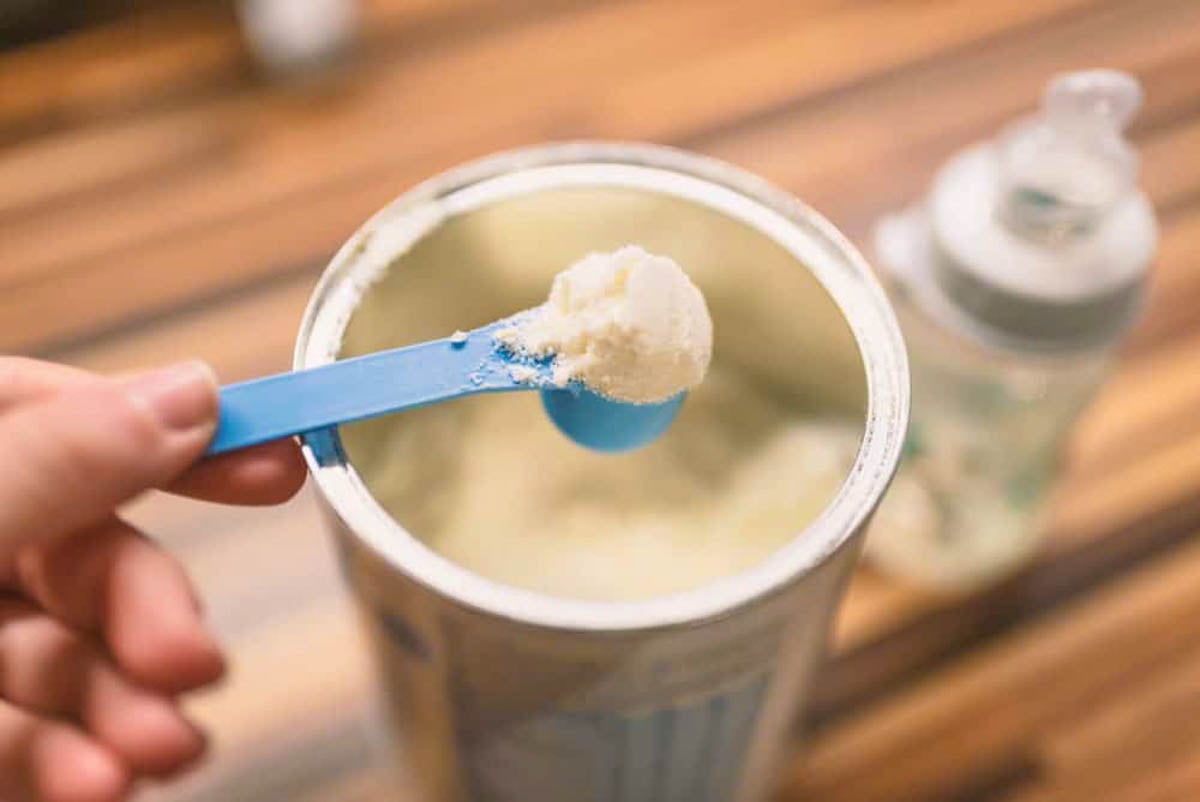

Symptoms Of Severe Acid Reflux In Infants
Now that we have explored the different types of acid reflux, how are you to know when your child has GERD, not just milk reflux?
The following is a list of the most common symptoms of GERD (source 1, source 2). If your child exhibits any of these, promptly make an appointment with their pediatrician, as they can indicate a serious condition:
- Refusal to eat or poor feeding
- Isn’t gaining weight or is losing weight
- Looks to be in pain during or after eating: cries, arches their back, or is irritable
- Coughing, choking, or trouble swallowing
- Wheezing, or difficulty breathing
- Blood in stool
- Stools that resemble coffee grounds
- Green or yellow spit up
- Blood in spit up
- Hoarse crying
- Baby’s belly is swollen, feels hard, or is distended
Treating Acid Reflux In Babies
If you anticipate that your baby has reflux, always speak with your child’s pediatrician to develop a treatment protocol. Depending on the severity or cause of their reflux symptoms, their doctor may include some of the following treatments:
Mild Reflux
To treat “milk reflux” or GER, your doctor may recommend any of the following treatments.
Smaller Feedings: Decreasing the amount of milk at each feeding while increasing the frequency can control the volume of food in your child’s tummy. Having less volume in the stomach at one time can reduce the likelihood of reflux (source).
Upright Feedings: To reduce the chances of regurgitation, feed your baby upright and keep them upright for 30 minutes afterward. Gravity can help keep the liquid in your baby’s stomach.
Adjusting Bottle Nipple Size: Too strong of milk or formula flow can give your baby too much fluid too fast. Your doctor may recommend decreasing your nipple size to slow your baby’s feeding rate. Furthermore, always keep the nipple full of milk as your child feeds. Ingesting air as they drink can cause feeding discomfort and increase their spit up frequency.
Thickening Formula: Some specialty formulas are already pre-thickened, and some people may add rice cereal to formula to thicken it. These are two very different methods, and only one is recommended. For formula-fed babies, some anti-reflux formulas will add additional starch to thicken it up slightly, making it harder to regurgitate (source). However, I don’t recommend adding rice cereal to formula directly, as it can be a choking hazard and can cause other complications with feeding (source).
Frequent Burping: Burping more often will help your child release air that gets caught in their digestive tract, and reduce spitting up (source). If formula feeding, burp your baby after every 1-2 ounces.
Severe Acid Reflux (or GERD)
If your child is exhibiting symptoms of GERD, or severe acid reflux, your doctor may recommend switching to a different formula. This is because many formula brands are made with cow’s milk, and cow milk proteins are known to aggravate reflux in some children (source).
Some doctors may also recommend starting antacid medication (source) or running additional tests. In rare and extreme cases, your doctor may recommend that your child see a gastroenterologist for treatment or surgery.
Note: Never start or switch formulas without speaking to your child’s doctor first. If you are concerned that your child has GERD, see your doctor first for diagnosis, a treatment protocol, and formula recommendations.
Switching Formulas To Treat Reflux
If your doctor recommends that you switch your baby’s formula to treat reflux, they may recommend different types of formula depending on the severity and cause of it:
- Happy Spitter: If your child is a happy spitter and isn’t in pain after spitting up, but your doctor is still concerned about their failure to gain weight, a formula created for acid reflux or a goat milk formula could be best for your little one.
- Milk Protein Intolerance: The best formulas for milk protein intolerance or cow milk protein allergy are hydrolyzed protein milk and A2 milk formula. Hydrolyzed infant formula, often called hypoallergenic formula, is made with broken-down proteins that are easier for your child to digest. A2 milk-based formulas, such as goat milk formulas, are made with a different type of casein protein that is also known to be easier on digestion.
- Lactose Intolerance: If your doctor determines that your child’s reflux issues stem from not tolerating lactose, the primary carbohydrate in many infant formulas, your doctor may encourage choosing a formula without lactose, such as dairy-free, plant-based, or soy-based formulas.
Best Formulas For Reflux
Now let’s get into the best formulas for acid reflux!
- Acid Reflux / Spit Up And Colic: This category of formulas is designed specifically for babies with acid reflux. Many of the formulas are made with thickeners to help the milk stay down, reducing regurgitation, and a few others are made with broken-down, or hydrolyzed, proteins. Though some of the formula brands say “AR” on the box, not all of them will.
- Goat Milk & A2 Milk Formula: The A2 milk protein found in goat milk is easier to digest than the A1 protein found in most cow milk (source), making it an easier-to-digest option. Since both goat milk and A2 milk formula are made with A2 proteins, I’ve added A2 cow milk formulas to this category as well.
- Hypoallergenic Formula: Instead of being made with more complex milk protein, hypoallergenic formulas are made with broken-down or pre-digested proteins or amino acids to make the formula easier for babies, especially those with cow milk allergies, to digest (source).
- Lactose-Free Formula: Since most formulas are made with lactose as the primary carbohydrate, lactose-free formulas are a great option for any babies diagnosed with lactose intolerance.
Acid Reflux / Spit Up And Colic
HIPP AR
HiPP AR is the best formula for reflux. It is made in Germany and has the cleanest ingredient list. It is non-GMO, sugar-free, free of pesticides, antibiotics, and hormones, and is made according to the strictest EU regulations. It is thickened with carob bean gum which helps the formula to stay down, preventing spit-ups without any added starches. This formula also contains prebiotics, probiotics, DHA, and ARA, making it a comprehensive and nutritious anti reflux formula.
Bobbie Organic Gentle Infant Formula
Made with 100% lactose as the only carbohydrate, just like breast milk, Bobbie Organic Gentle contains smaller milk proteins making it easier for babies to digest. It isn’t made with thickeners, but 75% of parents who fed this formula to their babies said it lowered the frequency of spitting up and gas (according to customer reviews on Bobbie’s website). For this reason, Bobbie Organic Gentle is the best formula for reflux and gas. Just because you’re choosing a gentle digestion formula for your kiddo doesn’t mean that you need to sacrifice health and nutrition, either: just like the standard Organic Bobbie Formula, their gentle variety is USDA-organic, non-GMO, Clean Label Project Purity certified, soy-free, and sugar-free.
Enfamil AR
This powdered formula is made specifically for babies with acid reflux making it another of the best formulas for spit up. Made with added rice, Enfamil A.R. has a thicker consistency which is known to reduce the frequency of spit ups by over 50% within one week. (Note: It is ok to buy formula thickened with rice, but likely not ok to thicken it with rice oneself at home – see the note about thickening formulas in the section above). This reflux baby formula also contains iron, DHA, ARA, and prebiotics. Maltodextrin and starch are also used to thicken the formula, but it has no added refined sugar or syrup solids. Enfamil A.R. is the best American-made acid reflux baby formula on the market today.
Enfamil A.R. Ready to Feed Infant Formula
For a ready-to-feed formula for spit up, Enfamil A.R. Ready to Feed baby formula bottles are the best bet. This pre-mixed formula is ready for your baby when they are, no measuring, mixing, or waiting required. This version of Enfamil A.R. is also thickened with rice starch, helping your child keep their formula down. Enfamil is the brand most recommended by pediatricians for acid reflux. Just keep in mind: it is not organic, uses carrageenan as a stabilizer, and has maltodextrin and starch, but otherwise has a relatively clean ingredients list: lactose from non-fat cow’s milk is the primary carbohydrate, there are no added refined sugars or syrup solids, and the formula includes prebiotics, DHA, and ARA.
Hypoallergenic Formula
HIPP HA
Long-chain milk proteins can be hard on babies’ digestion, so HiPP HA is made with proteins that have been hydrolyzed into smaller pieces. It is the best formula for gas and gentle digestion. This hydrolyzed protein formula helps improve any indigestion associated with milk allergies, but it can also help with adverse skin reactions and other allergic reactions. Though there is a small amount of starch added to HiPP HA, it’s only enough to give the formula a smooth and creamy texture similar to breast milk. This formula also contains probiotics, prebiotics, DHA, and ARA, making it one of the best hypoallergenic formulas. Note: because of strict European Union standards, hydrolyzed proteins cannot be certified organic but all of the other ingredients in this product are organic.
Enfamil Nutramigen Infant Formula
Choose Nutramigen if your child has been diagnosed with cow’s milk allergy (CMA / CMPA) or colic. Nutramigen by Enfamil is a gentle, lactose-free baby formula containing nutrients found in breast milk such as DHA, ARA, probiotics, and choline. This is the best formula for acid reflux and colic; it is clinically proven to relieve colic due to a cow’s milk allergy within 24 hours (according to Nutramigen’s website). Enfamil Nutramigen is made with extensively hydrolyzed proteins, which are the least likely to trigger an allergic response, and LGG, a probiotic studied for allergy management. Nutramigen is not organic and is made with corn syrup solids as the first ingredient, but it is one of the best reflux formulas and can be necessary if a more serious cow’s milk allergy is causing your baby’s reflux. (Note: When it comes to formula ingredients, carbohydrates like corn syrup and maltodextrin are not preferable because they’re highly processed – corn syrup solids is an added sugar, maltodextrin is a simplified starch that serves as a preservative/thickener).
Gerber Extensive HA
For a reflux formula designed for babies with cow’s milk protein allergies, Gerber Extensive HA can be another great option. Made with extensively hydrolyzed proteins, probiotics, and no lactose, this formula is specifically designed for children with cow’s milk protein allergy and intolerance, soy protein sensitivity, and fat malabsorption. It is the only 100% hydrolyzed formula on the market today, making it the best formula for milk allergy and acid reflux. While it’s not organic, it has a relatively clean ingredient list (although it does include maltodextrin) and does not contain any added sugar or syrup solids.
Neocate Infant with DHA and ARA
Neocate Infant is a hypoallergenic formula specifically designed for babies with food allergies who are 0-12 months of age. So, if your doctor has determined that cow’s milk or other food allergies cause your child’s discomfort, Neocate is a fantastic option. It is made with an amino acid base instead of hydrolyzed proteins. In addition, it is dairy-free, lactose-free, and made in a dairy and protein-free facility. The formula contains DHA and ARA and does not contain palm oil, soy oil, artificial flavors, colors, or sweeteners. It does, however, contain a high percentage of corn syrup solids.
EleCare
For another amino acid-based baby formula, consider EleCare. Similar to Neocate, it is made with 100% free amino acids, making it a superior option for babies who cannot tolerate hydrolyzed proteins or have a more severe cow’s milk protein allergy at the root of their acid reflux issues. EleCare has added DHA and ARA for brain and eye development. The formula does have corn syrup solids as the first ingredient, but it is safe for babies with food allergies.
RELATED: BEST HYPOALLERGENIC BABY FORMULAS
Goat Milk & A2 Milk Formulas
Jovie Goat Milk Formula
Jovie is my top pick when it comes to goat milk baby formula. It is made with full-cream, whole goat milk that is loaded with prebiotics. In addition, this formula is organic, contains no added refined sugar or syrup solids, has or preservatives, and contains essential fatty acids DHA and ARA which aren’t extracted with hexane. Unfortunately, Jovie is not vegetarian-friendly (due to the fish oil used for DHA) but otherwise, it is a fantastic goat milk formula option.
Kendamil Goat
Goat milk formula is a naturally easier-to-digest option for babies, as it contains A2 milk protein and more short and medium-chain fatty acids. These factors result in softer curds in young digestive systems, making digestion smoother. Kendamil Goat Milk Formula is made with full-fat goat’s milk. It has milk fat globule membrane and prebiotics, as does breast milk, making it a great formula for spit up and reflux. Kendamil is certified vegetarian-friendly and non-GMO, contains DHA and ARA, and has no palm oil, added sugars, or starches.
Kabrita USA
Kabrita Goat Milk Toddler Formula is technically made for children ages 12-24 months but meets the nutritional requirements for infant formula. If you choose to try this for your infant with reflux, make sure to get your pediatrician’s approval first. This formula is naturally easier to digest than cow’s milk, has a mild taste, and contains DHA, ARA, and prebiotics.
Aussie Bubs Goat Milk Infant Formula
Made in Australia with Australian goat milk, Aussie Bubs offers a high-quality and more affordable goat milk formula. This non-GMO option is vegetarian-friendly, made without added sugars, contains DHA and ARA, and is Clean Label Purity Project certified. If you’re looking for one of the best formulas for gas and reflux, Aussie Bubs is a great pick! It does not contain probiotics, but you can easily supplement them with your doctor’s approval.
Holle A2 Formula
Choose Holle A2 cow milk formula if your little one is determined to have a cow’s milk sensitivity. This formula is made with A2 cow’s milk. The A2 beta-casein protein type is typically easier to digest than A1 milk proteins, the more common protein in cow’s milk. This formula allows babies to continue drinking cow’s milk without the protein that causes the discomfort. Holle A2 contains DHA but does not have ARA, prebiotics, or probiotics.
RELATED: BEST GOAT MILK BABY FORMULAS
Lactose-Free Formulas
BéBé M Organic Rice-Based Infant Formula
BéBé M (BéBé Mandorle) Organic Anti-Reflux Rice-Based Infant Formula is a French-made formula that is 100% vegan and organic. It is made from an organic rice protein hydrolysate and organic coconut oil, almond oil, and rapeseed oil, making it ultra gentle on infant digestion. BéBé M is dairy-free and soy-free formula, making it a best formula for acid reflux and gas. It is also a safe option for children with cow’s milk allergy.
Note: This product is labeled as “Foods for special medical purposes (FSMPs)” and should be only given under medical supervision. Please consult your pediatrician before starting your baby on this formula.
Premibio Organic Vegan Baby Formula
A French vegan baby formula, Premibio is dairy-free, lactose-free, and made according to the strict regulations of the European Union’s European Food Safety Authority (EFSA). The formula is made with hydrolyzed rice protein, making it easy to digest, safe for children with cow milk allergies, and a great acid reflux baby formula. Though Premibio has added plant-based DHA, is organic, and is sugar-free, it does contain organic corn maltodextrin and doesn’t have prebiotics or probiotics.
Enfamil ProSobee Soy Sensitive
Enfamil ProSobee infant formula is designed for lactose-intolerant babies. It is a soy-based formula that is plant-based and non-dairy. Because it lacks lactose or milk proteins, it helps relieve fussiness and gas caused by milk-related allergies and sensitivities. Enfamil ProSobee comes in liquid, concentrate, or powder form and is generally easy to find and in stock in the United States. The formula contains GMOs and is not organic, though it is more affordable than most vegan and plant-based formulas.
Similac Soy Isomil Baby Formula
Similac Soy Isomil is a soy-based formula developed for babies with lactose intolerance, fussiness, and gas. It is easy to find in stores and is the most budget-friendly baby formula for spit up on this list. Derived from soybeans, Similac Soy Isomil is easy to digest, nutritionally complete, and contains DHA. Unfortunately, this formula’s number one ingredient is corn syrup solids, making it high in added sugar. It is also not organic and contains GMO ingredients.
RELATED: BEST PLANT-BASED AND VEGAN BABY FORMULAS
FAQs
Choosing the best bottle for reflux will go a long way in helping your baby feel more comfortable during feeding time. Pediatrician-recommended Dr. Brown’s Original Bottles are my top pick. These bottles have a patented vent system that prevents your baby from ingesting air as they feed, a known cause of mild reflux (source).
When it comes to reflux, a smaller nipple size is better. Although you don’t want the nipple to be so small that your baby becomes frustrated, larger nipple sizes can cause too much milk to be ingested at once, causing discomfort.
Brands generally determine bottle nipple size by age, but when it comes to preventing reflux, this sizing method isn’t always the best route. A good rule of thumb is to stick with the smallest-sized nipple your baby tolerates. You will know that your baby is ready to size up when your child falls asleep when eating, gets fussy while eating, takes longer to finish their bottle, or sucks fast without many swallows.
Studies show that breastfed infants have lower instances of reflux since breast milk empties from the stomach faster than formula (source). If you are breastfeeding your baby and they are showing signs of reflux, speak with your child’s doctor to determine the severity, cause, and potential treatment. If there is an allergen in your breast milk, your doctor should work with you to identify it so you can eliminate it from your diet. If your child still suffers reflux after making dietary changes, speak with your pediatrician about switching to an anti-reflux or hypoallergenic formula.
Many factors can trigger reflux in babies. The most common form of reflux in babies is mild reflux. It often occurs because infants eat a liquid diet and spend so much time on their backs. More severe forms of reflux, such as gastroesophageal reflux disease (GERD), can be caused by having more stomach acid, issues with how the lower esophageal sphincter works (source), or can be related to cow’s milk protein allergy or lactose intolerance (source).
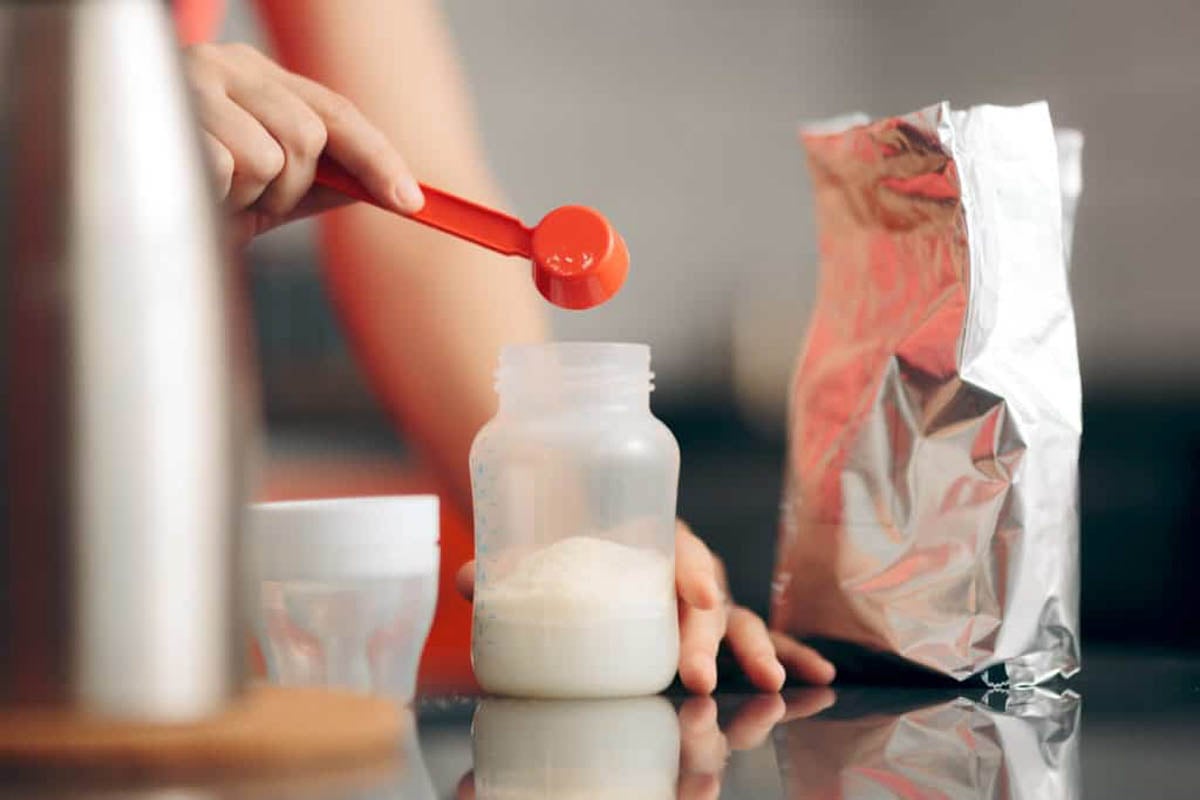

Final Thoughts
Whether it is your first time as a new parent, or your fifth child, being the parent of a newborn is tough. With sleep deprivation and potential hormones factoring in, I know how hard it can be to figure out what behaviors and situations are worth worrying about and which are part of normal and healthy early infancy.
Remember that spitting up is usually a normal part of this period. If you have any concerns about your child having gastroesophageal reflux disease (GERD), there are treatments and formulas that can help. As a first step, make sure to always bring your questions and concerns to your child’s pediatrician and they will help you determine the best course of action for your child. I hope this guide helped you navigate the world of anti-reflux formulas!
More Helpful Formula Guides
Health
Savory Vegetable Muffins | The Picky Eater

This post may contain affiliate links. As an Amazon Associate, I earn from qualifying purchases. Please read my disclosure.
I have perfected this savory vegetable muffins recipe packed with 6 different veggies including carrots, zucchini, spinach, and sweet corn. These muffins are ideal for anyone looking to add extra veggies into their diet, and are especially great for kids or busy adults needing a quick, healthy snack or easy breakfast. These hearty muffins are super easy to make, and require just 15 minutes of prep time!

If you want a fun and tasty way to start off your day, try my veggie muffin recipe! The muffins will keep you feeling full and energized, with no added sugar or overly processed ingredients. I really love how convenient they are for those busy weeks when I need something that requires minimal effort and time.
Made with creamy feta cheese, sweet corn, mild baby spinach, red bell pepper, and a handful of other ingredients, this recipe has amazing taste without overwhelming picky eaters. It’s a great way to get your kids to eat more veggies for sure!
My muffins with hidden veggies are perfect for toddlers – feel free to serve them on their own or pair them with my other healthy toddler lunch ideas; and can even be packed in school lunches for older kids! I’ll put them in my own lunch as well – they really do work for the whole family.
While it is no secret that I love sweet foods, traditional muffins are closer to a dessert than a hearty breakfast! Which is why I think of these vegetable muffins as the best of both worlds: they give all the comforting feels of freshly baked muffins, while also giving you a dose of healthy veggies!
They are full of flavor and have a soft, tender texture that my whole family loves. Plus, it is a great way to add more variety and healthy fiber to my kids’ diets!
If you’re a parent struggling to get your child to eat more veggies, this is the recipe for you.
They come in handy on busy mornings, making for the perfect grab-and-go breakfast. They’re also a great way to use up leftover veggies in the fridge. Sometimes I even make a double batch to meal prep, freezing some of the veggie muffins for later!
You’ll love how easy it is to customize this recipe. I’ll often switch up the flavor profile, with different vegetables and combinations. You could even make one batch with my traditional recipe and one with customizations. Look for some of my favorite flavor combinations in my variations section below!
With only 15 minutes of prep time and 25 minutes of bake time, everything comes together easily and quickly. Even if this is your first time making a recipe like this, it will be a breeze!
Latest Recipe Video!
🥘 Ingredients
My healthy savory muffins call for wholesome ingredients that you can easily find at any local grocery store. See the recipe card at the end of this post for full nutritional information.

Whole Wheat Flour: I use whole wheat flour for a boost of healthy fiber and whole grains. I also love the subtle flavor this flour provides compared to regular flour.
Baking Powder & Baking Soda: Both of these leavening agents allow the muffins to rise as they bake. You’ll get a lovely fluffy texture!
Seasonings: I like to use a combination of salt, rosemary, oregano, and garlic powder to add the best savory flavor. The aroma fills the house as the muffins bake!
Cheese: While the veggies are the star ingredients, the parmesan and feta crumbles make the best addition! They add so much flavor and texture, along with extra protein. I recommend skipping the pre-shredded cheese and shredding your own parmesan and feta from a high-quality block of cheese – because I think it tastes better. If your kids don’t like feta or parmesan, you can easily substitute it for any other cheese – shredded cheddar cheese or jack cheese are both great options.
Eggs: The eggs add a boost of protein as well as serve as the binder for the muffins. This recipe calls for 2 whole eggs.
Lemon Juice: This will enhance the flavor of these muffins, while also helping to activate the leavening agents. When I don’t have any lemon juice on hand, I’ll use some apple cider vinegar instead.
Extra Virgin Olive Oil: The olive oil helps to keep these muffins perfectly moist! Sometimes I swap this for other high-heat oils like avocado oil or melted coconut oil, too.
Oat Milk: While any milk could be used here (e.g. whole milk, soy milk, etc.), I like the subtle sweetness that oat milk adds to the muffins while not overpowering the savory notes.
Vegetables: Diced red bell pepper, chopped baby spinach, grated carrots, diced red onion, grated zucchini, and corn kernels will make the best combination of veggies in this recipe.
Sun Dried Tomatoes: This adds the perfect touch of sweetness and chewy texture throughout the savory muffins. If you do not have sun dried tomatoes on hand, I don’t recommend substituting them with regular diced tomatoes because they will make the batter too watery.
Fresh Basil: Basil perfectly complements the other ingredients, so you won’t want to skip this!
🔪 How To Make Vegetable Muffins
Learn how to prepare these vegetable muffins, by following my simple step-by-step instructions below:
Preheat & Prepare: I start off by preheating the oven to 350 degrees Fahrenheit /180 degrees Celsuis. Then, I line a 12 hole muffin pan with muffin liners (or use a silicone muffin tray instead).
Mix Dry Ingredients: Next, I add all ingredients from whole wheat flour through to parmesan cheese in a large mixing bowl and whisk together.

Mix Wet Ingredients: In a separate large bowl I’ll whisk together the eggs, lemon juice, oil and oat milk. Set aside.

Add Veggies & Feta: Stir the remaining ingredients through the dry ingredients.

Combine Wet And Dry: Gently fold the wet ingredients into the mixture until just combined.

Transfer To Tray & Bake: Transfer the muffin batter to the prepared muffin tray. I prefer to use an ice cream scoop or spoon for this step! Bake for 25 minutes, or until a toothpick inserted into the center of a muffin comes out clean.

Cool: Allow to cool completely on a cooling rack before serving.

My #1 Secret Tip for this recipe is to make sure you do not over mix the muffin batter.
Over-mixing the batter will result in dense, tough muffins. If you want that traditional light and fluffy style of muffin, go slow during this step. You’ll want to gently fold in the ingredients just enough to combine everything together.
Once the wet and dry ingredients combine, the mixing step is complete! You can transfer the batter to the tray and bake. Get excited for perfectly soft muffins!
Other Tips To Keep In Mind:
- Preparing Veggies: The carrots and zucchini can be shredded with a box grater – just be careful with your fingers as you get close to the ends of the vegetables. To save time you can also buy pre-shredded carrots.
- Introducing Veggies: For kids veggie muffins, I recommend starting with just 2 or 3 vegetables and see if they like them, especially for fussy eaters! You can add in more vegetables next time, as they become familiar with the tastes and textures.
- Serve Accordingly: Veggie muffins for toddlers or babies can be cut into small pieces or slices, depending on your little one’s age. I suggest pairing them with ketchup, plain yogurt, or cheese to entice your kids!
- Avoid Too Much Moisture: After washing the veggies, place them on a paper towel and make sure they are thoroughly dried to avoid excess water. Additionally, keep in mind that every veggie has a different moisture content. For better results, I like to use salt on the vegetables to draw out extra moisture, and squeeze them with a cheese cloth or paper towel prior to baking. I have made these muffins without doing this, and sometimes they turn out a little too wet. (Bonus tip: You can save the excess juice and add it to homemade vegetable broth or smoothies!)
📖 Variations
Mini Muffins: Sometimes I’ll add the batter to a mini muffin tray for a bite-sized version of these healthy vegetable muffins. This is perfect for finger foods at a baby shower or party. Mini muffins are also great for baby-led weaning, once your little one is ready!
More Protein: If you are looking for high protein savory muffin recipes, you can easily add in more protein. I love using hemp seeds or tempeh crumbles (and if you’re not vegetarian, bacon bits or ham pieces would work too).
Vegan Muffins: For dairy-free and egg-free muffins, replace the egg with an additional 4 tbsp olive oil. To make these easy veggie muffins fully vegan, use vegan cheese alternatives. Opt for a plant-based feta cheese, vegan parmesan, or nutritional yeast.
Gluten-Free Muffins: Use gluten-free flour instead of whole wheat flour to make these savory muffins gluten free. I recommend an all-purpose gluten free flour, oat flour, or a blend of almond flour and coconut flour.
Swap Veggies Or Spices: Alternative seasonings for these savory veggie muffins include black pepper, onion powder, thyme, sage, and paprika. You can also try different vegetables like spring onions, diced broccoli or cauliflower, shredded sweet potatoes, mushrooms, peas, or diced green bell peppers – just make sure to cut them up really small!
🍽 Serving Suggestions
These savory veggie muffins can totally be served on their own, but if you prefer to add more to your plate, these are some of my favorite ways to serve these muffins:
For A Larger Breakfast: Make the ultimate brunch buffet with a plate full of your favorite breakfast foods. Pair the muffins with a vegan frittata, oat milk pancakes, breakfast sausage, toast, and more. The options are endless for a healthy meal everyone will love.
With Sides: Sometimes I’ll serve my vegetable breakfast muffins alongside a bunch of sides like vegan roasted potatoes, breakfast fruit salad, or some slices of avocado for a light yet satisfying meal.
With Your Morning Drink: Instead of drinking caffeine on an empty stomach, enjoy your beverage with these healthy veggie muffins! They go great with the earthy notes of a lavender latte, while also complementing something sweeter like a biscoff latte.
🫙 Storing And Reheating
Refrigeration: Once cooled, I place leftover savory vegetable muffins in an airtight container and store in the fridge for up to 5 days.
Freezer: When I need longer lasting storage, I place the muffins into a freezer-safe plastic bag or air-tight container. Store frozen for up to 1 month. Allow the muffins to fully defrost before enjoying.
Reheating: While these veggie carrot muffins could be enjoyed chilled or room temperature, I think they are best when warm! Reheat the muffins in the microwave for 15-30 seconds, or place in the toaster oven for a few minutes. Carefully monitor to ensure the muffins do not burn.
❓Recipe FAQs
Instead of letting the muffins cool in the muffin tin, transfer them to a wire rack. This will help them cool evenly and prevent soggy texture from the moisture settling into the baked muffins. Another reason could be that the veggies had too much water. Two solutions to this are: salt and squeeze out the water prior to baking or roast the veggies and let them cool before adding them to the batter.
Any veggies that don’t have a super high water content are great to add to this veggie muffin recipe. While I provided my mix of veggies that I love in these muffins, you can get creative and add your favorite vegetables or anything you have in the fridge. My version calls for onions, bell pepper, carrots, zucchini, spinach, corn, and sun-dried tomatoes — but feel free to swap out one, or all of these for different veggies.
While there are many recipes for muffins with hidden veggies, this savory recipe highlights the vegetables rather than distract from them. Think of them in a similar way to egg bites! You can bring a favorable flavor to the veggies by adding in spices and herbs like salt, garlic powder, and basil. The addition of cheese will also make these more pleasing for picky eaters who may not necessarily be vegetable lovers. If you do prefer hidden veggie muffins, chop all the ingredients up very finely, or blend the vegetables in a food processor. Keep in mind, this will change the consistency of the muffin.
Yes! These muffins are great for baby led weaning, or for babies who have already started solid foods, but there are a few things to keep in mind:
1) Only introduce these muffins to babies who have experimented with finger foods – you could also make these into mini vegetable muffins for toddlers.
2) Make sure your baby doesn’t have any allergies to wheat, dairy or eggs before giving them these muffins (you’ll want to have them try each of these ingredients individually first)
3) You may want to reduce the amount of cheese to cut down the amount of sodium for your baby (read more about sodium for babies here).

Want to Save This Recipe?
Enter your email & I’ll send it to your inbox. Plus, get great new recipes from me every week!
By submitting this form, you consent to receive emails from The Picky Eater.
Love this plant based breakfast recipe? Please leave a 5-star rating 🌟 in the recipe below and/or a review in the comment section further down the page!
You can also FOLLOW ME on FACEBOOK, INSTAGRAM, and PINTEREST to see more delicious, healthy, family-friendly food, and if you have any questions, I’m here to help!
📋 Recipe Card
Savory Vegetable Muffins
I have perfected this savory vegetable muffins recipe packed with 6 different veggies including carrots, zucchini, spinach, and sweet corn. These muffins are ideal for anyone looking to add extra veggies into their diet, and are especially great for kids or busy adults needing a quick, healthy snack or easy breakfast. These hearty muffins are super easy to make, and require just 15 minutes of prep time!
Servings: 14 muffins
Calories: 134kcal
- To make this vegan-friendly, substitute the egg with an additional 4 tbsp olive oil, use nutritional yeast instead of parmesan cheese, and use vegan feta cheese.
- To make this gluten-free, use gluten free flour instead of whole wheat flour
- Do not over mix the batter.
- Allow the muffins to cool on a cooling rack.
- Store muffins in an airtight container in the fridge for up to 5 days.
- Muffins can be frozen for up to 1 month.
Serving: 1muffin | Calories: 134kcal | Carbohydrates: 22g | Protein: 6g | Fat: 3g | Saturated Fat: 1g | Polyunsaturated Fat: 1g | Monounsaturated Fat: 1g | Cholesterol: 27mg | Sodium: 238mg | Potassium: 343mg | Fiber: 4g | Sugar: 4g
Health
How to Minimize Eczema Flare-ups at the Gym and on the Job

Morning exercise offers many benefits, but for people with eczema, hitting the gym and then going to work presents a complex set of challenges. Getting hot and sweaty can lead to flare-ups. The breakfast you eat for post-workout energy may do more harm than good. And after a heavy workout that taxes your body, the stress of deadlines and other workplace pressures can be a trigger as well.
Bottom line: If you like to jump-start your workday at the gym, you need a smart strategy that will keep eczema at bay.
Enter Matt Knight, one of London’s most sought-after fitness experts. Inspired by a book by Arnold Schwarzenegger, Knight became serious about bodybuilding as a teenager (his training partner nicknamed him “Diesel”) and gained instant success as a personal trainer at a gym in his early 20s. But then the gym closed. On top of that, he suffered a shoulder injury that prevented him from exercising. His stress levels soared, and soon Knight was dealing with severe eczema all over his body, including foot flare-ups that made it difficult to walk.
“I used to stay awake at night scratching,” he recalls. “I had it so bad on the soles of my feet, they were cracked and bleeding, and I was on antibiotics.”
Knight went from doctor to doctor but didn’t find much relief – until he figured out on his own which foods sparked his flare-ups. When he changed what he ate, the flare-ups subsided. Meanwhile, Knight found ways to exercise without bringing on a bout of eczema, and that allowed him to revive his career, which greatly reduced his stress levels.
Now in fantastic shape, he’s eager to help others who want to work out, go to work, and avoid skin issues. Here, he offers three keys to managing your eczema at the gym and then heading off to a productive and itch-free workday.
1. Keep Cool and Clean
When Knight realized that constant patch tests didn’t solve the problem, he read up on his condition, noted what seemed to bring on flare-ups, and tried to eliminate his personal triggers. Becoming hot and sweaty is a big one for him, but it’s unavoidable if you’re exercising, as Knight does, to get results. So he came up with a post-workout solution: “What I do is to get as cool and clean as possible after a workout. I think a quick shower with cool water is great if you have heat-aggravated eczema. The key is, don’t let it go on for too long.”
The National Eczema Association recommends the “soak and seal” method:
- Shower for just 5 to 10 minutes, using a gentle, soap-free cleanser.
- Gently pat your skin dry, leaving it a little damp.
- Use any topical skin medication you are prescribed.
- Within 3 minutes of getting out of the shower, put moisturizer all over your body.
- Wait a few minutes before getting dressed, to give your skin time to absorb the moisturizer.
“You don’t want to wash away all your skin oils and leave your skin dry,” Knight says.
2. Reboot Your Breakfast
By analyzing his diet, Knight became aware that certain foods made his condition worse. “Make sure you are keeping inflammatory foods to an absolute minimum,” he says. Although there isn’t a clear link between eczema and food allergies, avoiding foods that spark an allergic reaction may reduce flare-ups, according to Cleveland Clinic. Common allergies include peanuts, gluten, and alcohol. Knight recommends limiting red meat, dairy, whole grains, flour, and sugar in your diet, and eating more fish and veggies. “Also, be mindful of certain so-called health foods,” he adds. “That whey protein shake and all those eggs can be doing much more harm than good.”
3. Amp Up Your Attitude
After you leave the gym, exercise the power of positive thinking. On your way to work, instead of worrying about a potential flare-up, remind yourself that you’ve done your best to prevent one. Breathe deeply, and tell yourself that whatever happens during the day, you can handle it. Look for ways to reduce your stress on the job. If you’re a manager, for example, you might learn to delegate.
And never throw in the towel. “Whether it’s stress, environmental, or food related, keep hunting for the answer and don’t disregard any possibilities,” Knight says, adding, “There is always an answer. Don’t quit searching for it.”
Health
Cows Are Potential Spreaders of Bird Flu to Humans

May 10, 2024 — Cow udders have the same receptors for flu viruses as humans and birds, raising concerns that cows could become “mixing vessels” that help the bird flu virus spread between people.
That’s according to new research conducted by scientists at the University of Copenhagen and St. Jude Children’s Research Hospital in Memphis and published as a preprint study in bioRxiv.
The scientists examined samples of brain, respiratory, and mammary gland tissue taken from a small number of cows and a calf. They stained the tissues and put it under the microscope to see what kind of receptors would be found.
They discovered that the sacs of the cows’ udders were loaded with the kind of flu receptors associated with birds as well as those found in people. These receptors are the kind that bird flu viruses like H5N1 can attach to. Tissue from the brain and respiratory tract of the cows had far fewer of the receptors.
“These results provide a mechanistic rationale for the high levels of H5N1 virus reported in infected bovine milk and show cattle have the potential to act as a mixing vessel for novel [influenza virus] generation,” the researchers wrote in the study.
When an animal acts as a mixing vessel, different flu strains can swap genetic material to form new kinds of diseases.
Pigs can be infected with human and bird flu viruses and have previously been thought of as possible mixing vessels for viruses that could pose a pandemic threat, Stat News reported. The new study suggests that cows could become mixing vessels for a bird flu pandemic.
“The new pre-print shows convincingly that cows harbor both human-flu and avian-flu receptors in their mammary glands,” Sam Scarpino, PhD, director of artificial intelligence and life sciences at Northeastern University, said on X, formerly known as Twitter. “As a result, dairy cattle *may* have similar potential as pigs to serve as evolutionary intermediaries between avian and human flus.”
Since late March, bird infections have been found in 42 herds across nine states, according to the USDA.
-

 African History4 months ago
African History4 months agoBlack History Facts I had to Learn on My Own pt.6 📜
-

 African History4 years ago
African History4 years agoA Closer Look: Afro-Mexicans 🇲🇽
-

 African History1 year ago
African History1 year agoPROOF AFRICAN AMERICANS AIN'T FROM AFRICA DOCUMENTED EVIDENCE
-

 African History2 years ago
African History2 years agoHow Did Normal Medieval People Survive Winter? | Tudor Monastery Farm | Chronicle
-

 African History3 years ago
African History3 years agoThe Entire History of Africa in Under 10 Minutes – Documentary
-

 African History3 years ago
African History3 years agoWhat happened to the many African Kingdoms? History of Africa 1500-1800 Documentary 1/6
-

 African History2 years ago
African History2 years agoAFRO MEXICO: Black History In Mexico!
-

 African History1 year ago
African History1 year agoA Black African King in Medieval European Art

